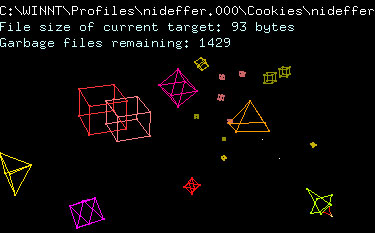Internet Art Included in Whitney Museum Biennial Exhibit
|
In PROXY you will find:
|
 Internet art by Robert Nideffer, Assistant Professor of Studio Art at UC Irvine, has been selected for inclusion in the Whitney Museum of Art's Biennial Exhibition, one of the premier reviews of contemporary American art. Nideffer's work, entitled "PROXY", has recently received sponsorship from the newly established California Institute for Telecommunications and Information Technology, which will facilitate continued research and development on the project.
Internet art by Robert Nideffer, Assistant Professor of Studio Art at UC Irvine, has been selected for inclusion in the Whitney Museum of Art's Biennial Exhibition, one of the premier reviews of contemporary American art. Nideffer's work, entitled "PROXY", has recently received sponsorship from the newly established California Institute for Telecommunications and Information Technology, which will facilitate continued research and development on the project.
PROXY is an Internet experience in which the participants become agents in peer-to-peer exchanges of information from local sources and from the web, guided in part by their active choices and in part by choices the system makes for them based on their self-descriptions. It includes features often found in games, such as teleportation; and features often found among game players, such as deliberate misrepresentation; but it also includes access to real files on the Internet. It is thus an exercise in self-representation as well as an exploration on the web. PROXY is, as Nideffer describes it, a "head game about knowledge discovery, file-sharing, and information mis/management in relation to networked identity construction and collective behavior." He says it is an art project, a game, and functional software all in one. "It's a game that's not always very fun, an artwork that would never be considered 'art' by many people, and a software that's as intentionally dysfunctional as it is functional."

The Whitney Biennial 2002 will open in New York on March 7 and will run through May 26. Inclusion in the Bicentennial was limited to 113 artists selected by the museum's curators. Some of the works are very traditional, and some are very avant-garde; they come in all medias and formats. Some of the artists are well known; others are just now being recognized. Painting, video, performance art, and architectural design, for example, are all included. Internet art is a new category, first included in the 2000 Biennial.
The California Institute for Telecommunications and Information Technology, called Calit², was established in 2000 as one of four Institutes for Science Innovation, all on UC campuses, established by state appropriations and matching funds from industry. Calit² exists as a consortium on two campuses, UC San Diego and UC Irvine. Calit² seeks to stimulate and understand the future development of the Internet and telecommunications, including the development of media arts. Robert Nideffer is one of the artists, scientists, and programmers at UC Irvine working on Institute projects in such areas as computer gaming, virtual reality, and robotic art. They seek to provide more instances in which artistic practice guides technological advances and anticipates the social and cultural implications.
All of Nideffer's works concern technology and culture, contemporary social theory, and electronic intermedia. For example, "Tomb Raider" is a playfully critical review and analysis of the well-known computer game; "Historic Insertions" is a set of famous paintings to which Nideffer has digitally added images of himself; and "The Fine Art of Appropriation" is a web-based piece that addresses both the value and the dysfunctions of appropriating the work of others. Nideffer was one of the curators for "Shift-CTRL", a cultural examination of games and gaming, which was the inaugural exhibit of the Beall Center for Art and Technology at UC Irvine in late 2000. Nideffer was also a founding editor of the electronic journal called SPEED, devoted to the study of technology, media, and society.
Nideffer has a Ph.D. in Sociology as well as an MFA in Studio Art, both from UC Santa Barbara. He has been on the faculty of UC Irvine since 1998 and affiliated with Calit² since the fall of 2001. He has a courtesy appointment with the Department of Information and Computer Science and is an affiliated faculty with the Visual Studies Program.
For more information contact Stuart Ross, Calit², at (949) 824-9602.
